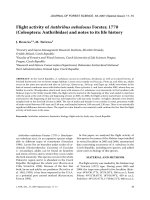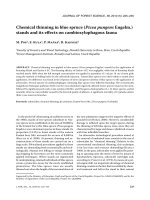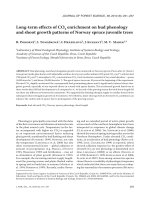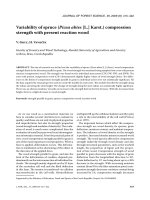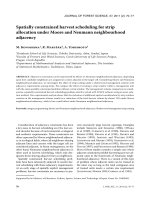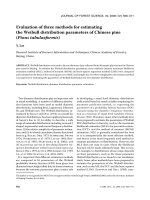Báo cáo lâm nghiệp: "Spatially constrained harvest scheduling for strip allocation under Moore and Neumann neighbourhood adjacency" pdf
Bạn đang xem bản rút gọn của tài liệu. Xem và tải ngay bản đầy đủ của tài liệu tại đây (361.18 KB, 8 trang )
70 J. FOR. SCI., 57, 2011 (2): 70–77
JOURNAL OF FOREST SCIENCE, 57, 2011 (2): 70–77
Spatially constrained harvest scheduling forstrip
allocation under Moore and Neumann neighbourhood
adjacency
M. K
1
, R. M
2
, A. Y
3
1
Graduate School of Life Sciences, Tohoku University, Aoba, Sendai, Japan
2
Faculty of Forestry and Wood Sciences, Czech University of Life Sciences Prague,
Prague, Czech Republic
3
Department of Mathematical Analysis and Statistical Inference, The Institute
of Statistical Mathematics, Tachikawa, Tokyo, Japan
ABSTRACT: Adjacency constraints can be represented by Moore or Neumann neighbourhood adjacency, depending
upon how candidate neighbours are assigned at corners adjacent to the target cell. Considering Moore and Neumann
neighbourhood adjacency, we investigate the effect of strip cutting under a shelterwood management scheme with
adjacency requirements among strips. We compare the effect of creating a strip window within a management unit
with the same spatially constrained problem without a strip window. The management scheme comparison is consid-
ered as a spatially constrained harvest scheduling problem, which is solved with CPLEX software using an exact solu-
tion method. Our experimental analysis shows that the inclusion of additional spatial consideration by strip window
creation in the management scheme results in a reduction of the total harvest volume by almost 13% under Moore
neighbourhood adjacency, while it has a small effect under Neumann neighbourhood adjacency.
Keywords: integer programming; Moore and Neumann neighbourhood adjacency; Shelterwood management stripcutting
Consideration of adjacency constraints has been
a key issue in harvest scheduling over the last sev-
eral decades because of environmental, ecological,
and aesthetic requirements. ese constraints are
often expressed by Moore neighbourhood adjacen-
cy in ecological fi elds, where all neighbours sharing
adjacent lines and corners with the target cell are
considered adjacent. In forest management, on the
other hand, Neumann neighbourhood adjacency is
often used in harvest scheduling, which only des-
ignates those sharing adjacent lines as neighbours.
Spatially constrained harvest scheduling prob-
lems have been intensively analyzed to resolve har-
vest scheduling with these adjacency requirements.
At an early stage of spatially explicit management
problems, harvest constraints are necessary to pre-
vent excessively large harvest openings. Examples
include S and S (1988), O’H
et al. (1989), C et al. (1990), N and
B (1990), N et al. (1991), D and
N (1993), J and W (1993),
L and M (1993), Y et al.
(1994), M and C (1995), H and
T (1997), and H and B (1998).
Most of these studies consider a simple case where
adjacent constraints prohibit harvesting any two ad-
jacent units in the framework of Neumann neigh-
bourhood adjacency. ere is a variant of this type
of problem where adjacent units can be treated in
the same way as long as the total contiguous area
of treated units meets a certain size requirement
(L, M 1993; C et al. 1995).
Supported by he Ministry of Education, Culture, Sports, Science and Technology of Japan, Grant No. 18402003.
J. FOR. SCI., 57, 2011 (2): 70–77 71
section, we present our case study, and then con-
cluding remarks are provided in the fi nal section.
Although the shelterwood system requires several
preparatory cuttings – commonly over 30 years or
three periods – before fi nal cutting, we assume one
harvesting activity includes a series of these pre-
paratory cuttings and the fi nal cut for each strip at
each period. In other words, we focus on the start-
ing period that begins the silvicultural treatment
for each strip. Subject to the adjacency require-
ment, we assume that two adjacent strips cannot
be treated during the same harvesting period.
Formulating the spatially constrained
shelterwood management problem
We formulate our shelterwood management
problem over the regeneration period (or three
periods) using a 0–1 integer programming frame-
work. We assume a forester manages several con-
tiguous stands that are divided into several strips.
e objective is to maximize the total cut volume
from all strips over the regeneration period. Con-
straints include harvest fl ow and land accounting,
as well as spatial restrictions to avoid harvesting
two adjacent strips during the same period. Har-
vest constraints, which are often required in forest
operations, stipulate a non-declining, even fl ow of
timber. Such constraints refl ect one interpretation
of “sustainable timber supply” and ensure a contin-
uous supply of wood. Land accounting constraints
limit harvest to – at most – one cut during the
planning horizon. As a result, we can only consider
a single treatment and must assume that replanted
stands will not reach a profi table age within the
planning horizon. Adjacency is defi ned by either
Moore neighbourhood adjacency or Neumann
neighbourhood adjacency.
Let X = (x
1
, , x
m
)' = (x
1
, , x
n
) be an (m × n)
dichotomous decision matrix with m as the num-
ber of strips and n as the number of treatments (or
periods in this paper to specify that only one treat-
ment can be started for each strip over the plan-
ning period), and ' denotes the transpose, where x
i
is the i
th
row vector of X for the ith strip and x
j
is
the j
th
column vector for treatment starting at the
j
th
period. An element of X is thus defi ned by
where only three periods are explicitly considered (i.e.
j = 1, 2, 3 with n = 3), with strip harvesting beginning
during the fi rst, second or third period, respectively.
e extension of a spatially constrained problem
can be found for example in S and RV
(1996), who incorporated interval exclusion periods
for multiple harvests in the same unit. Exclusion
periods for harvesting among adjacent units were
considered by Y (2001) and B and
B (2001, 2006). ese studies developed
many heuristics with diff erent algorithms. e na-
ture of a heuristic is such that it produces a feasible
or near-feasible, and hopefully very good, but not
necessarily optimal, solution within a reasonable
computational period. As a consequence, such heu-
ristics can result in inaccurate estimates for eco-
nomic analysis within an optimization framework.
In many European countries, a shelterwood silvi-
cultural system that supports natural stand regen-
eration has traditionally been the recommended
management regime. Under the shelterwood system,
management units are often fi rst divided by a strip
window, where the unit is harvested in a series of like-
sized, uniformly staggered linear strips that advance
progressively through the unit in one direction, most
often perpendicularly to the prevailing wind. Partial
or clear-cutting takes place in each strip with adjacen-
cy requirements among strips. Because of these ad-
jacency requirements, this shelterwood silvicultural
system with strip cutting can be treated as a spatially
constrained harvest scheduling problem.
e objective of this paper is to compare the ef-
fect of creating a strip window within a management
unit – assuming adjacency requirements among
strips imposed by both Moore and Neumann neigh-
bourhood adjacency – with the same spatially con-
strained problem without a strip window. In the
context of a spatial harvest scheduling problem,
the choice of adjacent structures – either Moore
or Neumann neighbourhood adjacency – in defi n-
ing adjacency relationships can substantially aff ect
management goals. Increased restrictions in units
harvested under Moore neighbourhood adjacency
could result in lost harvested timber volume, which
in turn reduces profi t generated from shelterwood
forest management. erefore, it is important to
quantify and examine diff erences in harvested tim-
ber volume under the two diff erent adjacency struc-
tures. Furthermore, comparing these two types of
strip-based management with a conventional (i.e.
without strip, management-unit-based) manage-
ment scheme will provide useful information for de-
veloping and implementing an effi cient strip-based
shelterwood management regime.
In the next section, we present the target spatial-
ly constrained harvest scheduling problem within
an integer programming framework. In the third
x
~
x
~
x
~
=
0
1
,
x
ji
1
0
if the treatment is implemented
at the j
th
period for i
th
strip
otherwise
72 J. FOR. SCI., 57, 2011 (2): 70–77
In the Fig. 1 example, neighbourhood adjacency
to the central target cell can be defi ned as follows:
1. for Moore neighbourhood adjacency,
NB
0
= {1,2,3,4,5,6,7,8}
2. for Neumann neighbourhood adjacency,
NB
0
= {1,2,3,4}
Using the matrix notation that follows Y
and B (1994), another simple approach is to use
an adjacent matrix A, like in network theory:
M × x
j
< m
0
, j = 1, 2, 3 (6)
where
m
0
= A × 1
m
(7)
M = A + diag (m
0
) (8 )
and an element of the above adjacent matrix A is
defi ned by
(9)
As a result, our harvest scheduling problem is for-
mulated by the following integer programming formu-
lation (to be solved using exact solution techniques):
subject to
1'
n
x
i
< 1, i = 1, 2, , m
M × x
j
< m
0
, j = 1, 2, 3
where an individual decision variable is x
i,j
Є
{0,1}.
In the case study that follows, we use this analy-
sis to compare the eff ect of creating a strip window
within a management unit with the same spatially
constrained problem without a strip window.
Overview of the study site
Our case study considers a forest managed by the
School Forest Enterprise at the Technical University
in Zvolen, Central Slovakia. Our study encompasses
an area of 950 ha with 104 units. e rotation period
in this forest is approximately 110 years with a re-
generation period of 30 years; regeneration cutting
starts at age 80 and is completed by age 110. ere
are 13 age classes (10-year range) represented in the
forest. e age structure is unbalanced with young
and mature groups of stands. e species composi-
tion is approximately 86% broadleaf and 14% conif-
Because we focus on the initial period that begins
shelterwood treatment for each strip (in an attempt
to examine the eff ect of strip cutting on manage-
ment effi ciency), we do not consider the cutting or-
der, which is assigned sequentially over space.
e objective here is given by
(1)
where C is an (m × 3) coeffi cient ma trix and its element,
c
i,j
represents the total volume obtained by the treatment
or decision x
i,j
.
Note that if the current strip is too young to be
cut, the corresponding coeffi cient of the treatment
becomes zero, so we can maintain the same set of
treatments, or decision variables, for all strips.
e harvest fl ow constraint is formulated as fol-
lows: Let
( )
p
ji
v
,
be a harvest volume at the p-th period
from the decision variable x
i,j
, and the correspond-
ing m × 3 matrix V
p
as the harvest volume matrix.
Harvest fl ow constraints are then specifi ed by
(2)
or
(3)
e latter is to allow ± a fl uctuation of harvest
fl ow, and is used here to ensure the problem re-
mains valid in an integer programming framework.
In other words, harvest fl ow constraints prevent
the volume of timber extracted during each period
from being higher or lower than ± a fl uctuation.
To formulate land accounting constraints, which
require at most one treatment for each strip, we
have the following:
1'
3
x
i
< 1, i = 1, 2, , m (4)
where 1
3
= (1,1,1)' is a (3 ×1) vector with a value of 1.
A djacency constraints are defi ned by either Moore
neighbourhood adjacency or Neumann neighbour-
hood adjacency. Fig. 1 shows how each of them is
typically structured, using an example of spatial
map. e central cell is the target and the surround-
ing cells its neighbours. As the fi gure demonstrates,
there are eight neighbours adjacent to the target cell
under Moore neighbourhood adjacency, but only
four under Neumann neighbourhood adjacency. To
avoid cutting two adjacent strips in the same period,
it is simplest to use a pair-wise constraint:
(5)
where: NB
1
is a set of strips adjacent to the i
th
strip.
( )
∑∑
= =
⋅=
′
=
m
i j
jiji
x
xcZ
1
3
1
,,
trmax XC
∉
∈
=
i
i
ji
NBj
NBj
a
if 0
if 1
,
(
)
(
)
(
)
(
)
(
)
,tr1trtr1
11
′
+≤
′
≤
′
−
−− ppp
XVXVXV
αα
x
~
x
~
( )
∑∑
= =
⋅=
′
=
m
i j
jiji
x
xcZ
1
3
1
,,
trmax XC
×
( )
,tr
0,
1
3
1
)(
,
=⋅=
′
∑∑
= =
vxv
ji
m
i j
p
jip
XV
×
p = 1, 2, 3
p = 2, 3
,,1
,,
∈≤+
∀
NBkxx
ijkji
j = 1, 2, 3
p = 2, 3
(1–α)tr(V'
p –1
X) < tr(V'
p
X) < (1+α)tr(V'
p –1
X),
J. FOR. SCI., 57, 2011 (2): 70–77 73
erous species, with beech accounting for 69% of for-
est cover and spruce for 13%. e forest landscape is
presented in Fig. 2. Dark coloured areas are mature
stands at the age of 80 years or older, representing
the total area of 529 ha.
Growth data for this study was obtained from a
regular forest inventory conducted in 2003, and is
depicted in Fig. 3 (M 2003). e following
Richards growth function (R 1958) was
used to project growth over the time horizon:
w(t) = 677.6862 × (1 – e
–0.04510663 × t
)
24.22714
(10)
where w(t) represents volume per hectare at age t.
In the case of strip window management, each
forest stand was divided into strips following com-
mon shelterwood management conventions for
strip width and forest stand borders. Strips were
created one-by-one in a uniform direction, con-
sidering adjacency requirements. Post-treatment,
there were 1,274 strips – more than 10 times the
original number of units – with an average area of
0.74 ha. Harvestable timber volume in the i
th
strip
in period j represents the volume harvested from
shelterwood management – a series of preparatory
cuttings and the fi nal cutting – when shelterwood
management was assigned to strip i in period j.
In the case of conventional management with-
out a strip window, each stand represents a man-
agement unit and can be harvested in any period
(i.e. 1
st
, 2
nd
or 3
rd
) during the planning horizon.
Harvestable timber volume in a management
unit in period j represents the volume harvested
from this unit in period j, which can be computed
by multiplying vol/ha generated from the above
growth equation by the area of the unit. e objec-
tive of this study is to examine how the introduc-
tion of strips in a management unit aff ects man-
agement effi ciency, assuming the management goal
is to supply a sustainable volume of timber (which
is the management mandate of the School Forest
Enterprise). erefore, we only consider Neumann
neighbourhood adjacency as an adjacent structure
for a conventional management-unit-based prob-
lem, which generates a higher timber volume be-
cause of fewer harvest restrictions when compared
to Moore neighbourhood adjacency.
Strip cutting eff ects on management scheme
e analysis was conducted with and without
strip windows over three periods. We used fi ve
values for fl ow allowance on harvest fl ow change
over time – 10%, 1%, 0.1%, 0.01% and 0.001% (al-
most even) – because even-fl ow constraints are
often violated. We fi rst solved a spatially con-
strained problem without considering a strip win-
dow, where adjacency was expressed by Neumann
Fig. 1. (a) Moore and (b) Neumann neighborhood adjacency
structures
(a) (b)
Fig. 2. Map of the forest management unit in Zvolen, Slovakia
< 80 years
< 80 years
Fig. 3. Growth projection
600
400
200
0
Volume (m
3
·ha
–1
)
80 100 120 140
Age (years)
74 J. FOR. SCI., 57, 2011 (2): 70–77
neighbourhood adjacency. Fig. 4 shows the fi nal
solution over three periods with 10% fl ow allow-
ance. Among 55 units eligible in the fi rst period,
19 were selected for harvesting. As time pro-
gressed, the number of units available for har-
vest increased, so that 21 were harvested in the
second period and 22 in the last (Table 1). e
area remaining eligible for harvest changed from
352.71 ha in the fi rst period to 200.80 ha in the
second and 12.65 ha in the third. Harvest fl ow
changed from 95,176m
3
to 113,468 m
3
, with the
total harvest volume of 312,574 m
3
. Imposing low-
er fl ow allowance, the total harvest volume was re-
duced to 308,381 m
3
with a very even-fl ow level of
102,794 m
3
over time (Table 2).
Neumann neighbourhood adjacency was next
applied to a strip shelterwood management regime.
With strip windows in the units, we calculated the
fi nal solution depicted in Fig. 5 with 10% fl ow al-
lowance. Among strips, only line-adjacent cuts
were avoided. As the number of strips increased
approximately ten-fold, 709 strips were eligible for
harvest at the beginning of the fi rst period. Of these
strips, 234 were cut in the fi rst period, 271 in the
second, and 279 in the third (Table 1). e remain-
ing area eligible for harvest in each respective pe-
riod was 351.63 ha, 198.47 ha, and 13.10 ha. Har-
vest fl ow changed from 94,119 m
3
to 113,797 m
3
with the total harvest volume of 311,414 m
3
. With
lower fl ow allowance, the total harvest volume was
reduced slightly to 309,240 m
3
with an even-fl ow
of 103,080 m
3
over time ‒ slightly more than the
previous scenario without strip windows (Table 2).
is could be so because, subject to the fl ow con-
straints, there are more possible combinations for
selecting strips and still meeting the objective. In
other words, when compared to the original larger
forest stands, smaller strips make it easier to meet
the fl ow constraints.
Moore neighbourhood adjacency restricts har-
vest opportunities. Under this regime, 207 strips
are cut in the fi rst period, 221 in the second, and
233 in the last. Among strips eligible for harvest at
the beginning of the fi rst period, 368.56 ha were left
uncut in the fi rst period, 242.93 ha in the second,
and 84.51 ha in the last (Table 1). Unlike the solu-
tions from the Neumann neighbourhood adjacency
scenario, an area of 84.51 ha ‒ almost six times the
other cases ‒ was reserved for subsequent harvest-
ing by the Moore neighbourhood adjacency man-
agement scheme. In other words, the creation of
strip windows under Moore neighbourhood adja-
cency seems to reduce the current harvest oppor-
tunity, but it indirectly reserves resources for future
harvesting (Fig. 6). e total volume harvested was
reduced by 12.38% with a 10% allowance (Table2).
It was slightly increased to 11.92% as the fl ow al-
lowance became tight at 0.001%. Harvest fl ow
changed from 82,851 m
3
to 100,051 m
3
with a 10%
fl ow allowance (Table 2).
Table 1. e number of cutting units and remaining uncut area with 10% fl ow allowance
Period
Ordinary under
Neumann adjacency
Strip cutting under
Neumann adjacency
Strip cutting under
Moore adjacency
# of units cut
remaining area
with age
> 80 years
# of strips cut
remaining area
with age
> 80 years
# of strips cut
remaining area
with age
> 80 years
1 19 352.71 234 351.63 207 368.56
2 21 200.80 271 198.47 221 242.93
3 22 12.65 279 13.10 233 84.51
Fig. 4. Final solution without strips under Neumann neigh-
borhood adjacency with 10% fl ow allowance
No cut
First implementation
Second implementation
ird implementation
J. FOR. SCI., 57, 2011 (2): 70–77 75
DISCUSSION AND CONCLUSION
e strip shelterwood forest management system
specifi es strip windows for harvest and regeneration
of forest stands, along with an adjacency require-
ment among strips. e adjacency requirement is an
important aspect of the shelterwood system because
it requires leaving corresponding adjacent strips un-
cut during the regeneration period on one strip. In
this paper, we investigated the management eff ects
Table 2. Results from three spatially constrained management scheme
Flow allowance (%)
10 1 0.1 0.01 0.001
No strips
under Neumann
adjacency
period 1 95,176 102,880 103,047 102,880 102,794
period 2 103,929 103,548 103,106 102,871 102,793
period 3 113,468 104,044 103,080 102,878 102,794
total harvested volume 312,574 310,471 309,233 308,629 308,381
base % 100 100 100 100 100
Strips under
Neuman
adjacency
period 1 94,119 102,187 102,995 103,080 103,079
period 2 103,498 103,198 103,091 103,071 103,080
period 3 113,797 104,104 103,171 103,079 103,080
total harvested volume 311,414 309,488 309,257 309,230 309,240
relative diff erence (%) 99.63 99.68 100.01 100.19 100.28
Strips under
Moore adjacency
period 1 82,851 89,774 904,96 90,546 90,546
period 2 90,967 90,635 90,543 90,547 90,545
period 3 100,051 91,504 90,634 90,546 90,545
total harvested volume 273,868 271,914 271,673 271,639 271,635
relative diff erence (%) 87.62 87.58 87.85 88.01 88.08
No cut
First implementation
Second implementation
ird implementation
No cut
First implementation
Second implementation
ird implementation
Fig. 5. Final solution with strips under Neumann neighbor-
hood adjacency with 10% fl ow allowance
Fig. 6. Final solution with strips under Moore neighborhood
adjacency with 10% fl ow allowance
76 J. FOR. SCI., 57, 2011 (2): 70–77
of strip cutting under the strip shelterwood manage-
ment system with adjacency requirements imposed
by Moore neighbourhood adjacency and Neumann
neighbourhood adjacency, examining the eff ect on
the volume and area harvested, as well as harvest
fl ow over the planning horizon. We compared the ef-
fect of creating a strip window within a management
unit with the same spatially constrained problem
without a strip window. For a case study, we selected
a forest managed by the School Forest Enterprise at
the Technical University in Zvolen, Slovakia.
With an objective of maximizing the total harvest-
ed volume, we showed the following: given 529 ha of
mature forest units eligible for harvest, 33% of the
area was harvested in the fi rst period in both the sce-
nario without strip windows and the scenario with
strip windows subject to Neumann neighbourhood
adjacency. 30% was harvested in the scenario with
strip windows subject to Moore neighbourhood ad-
jacency. us, as a whole, avoiding corner-adjacent
strip cutting under Moore neighbourhood adja-
cency reduced the total harvest volume and harvest
fl ow by approximately 13%.
From a sustainable harvest perspective, howev-
er, the scenario with strip windows under Moore
neighbourhood adjacency reserved about six times
more area for future harvest than the other sce-
narios, which held almost no area in reserve. is
implies that the creation of strip windows in for-
est stands under Moore neighbourhood adjacency
could play an indirect role in preserving some re-
sources for future harvest, possibly meeting sus-
tainable management objectives.
is analysis also demonstrates that more latitude
in cut unit selection would contribute to meeting
management goals more effi ciently. Our compari-
son of “with” and “without” strips shows that strip-
based management, which gives managers greater
choice in selecting trees to cut, more closely meets
the harvest fl ow constraint. Management science
theory has argued that allowing more latitude in
management decisions improves management out-
comes. Our results confi rm this argument and sug-
gest that creating strip windows not only contrib-
utes to a sustainable use of forest resources but also
it may improve management effi ciency.
We limited our analysis to a three-period horizon
because this is a common forest management plan-
ning window. Further analysis is needed to investi-
gate the long-term eff ect of strip window creation
under the shelterwood system. Nonetheless, by
modelling spatial adjacency in shelterwood man-
agement and comparing diff erent adjacency struc-
tures, we were able to explore a management plan
that explicitly addresses the effi cient spatial alloca-
tion of a forest treatment and examine the eff ect of
strip creation on management effi ciency. Although
we only consider a strip shelterwood management
system in this study, our spatial harvest scheduling
model can be extended to another type of shelter-
wood system called the “group” method, which re-
moves groups of trees at each cut.
1)
In this case, we
would fi rst need to develop a rule that determines
the size and spatial pattern of a “group” within a
management unit. e rule must refl ect those for-
est attributes necessary to grow a stand into a “tar-
get” condition. (For example, the percentage of re-
maining canopy cover required to provide enough
protection and space for regeneration should be
considered.) en, we would formulate a spatially
explicit forest management plan with adjacency
constraints that prevents harvesting two adjacent
“groups” simultaneously.
As the ecological and environmental aspects of
forest management gain more and more attention,
the need for forest management that explicitly ad-
dresses these concerns has increased. Additionally,
there has been an increasing interest in studies that
integrate ecology into management science and
economic analyses. As we demonstrated in this
study, exploring and examining those ecological
concepts within an optimization framework will
provide useful information and support for im-
proving the effi ciency and eff ectiveness of forest
management that aims to balance ecological and
economic objectives.
R ef er e nc e s
B K., P. B (2001): e economic impact of
green-up constraints in the Southeastern U.S.A. Forest
Ecology and Management, 145: 191–202.
B K., P. B (2006): An economic and landscape
evaluation of the green-up rules for California, Oregon, and
Washington (USA). Forest Policy and Economics, 8: 251–266.
1)
Another implementation of the shelterwood system is often called the “uniform” method, where harvested trees are
evenly scattered throughout a management unit. The proposed model cannot address the spatial pattern of a single
tree within a management unit. A spatial pattern of individual trees, which involves a decision on which trees should
be removed within a management unit, is generally determined on-site. We often treat these types of operational plans
differently than a harvesting schedule.
J. FOR. SCI., 57, 2011 (2): 70–77 77
C B., L V., P L. (1995): Timber harvest
scheduling with adjacency constraints: Using arcinfo to
make FORPLAN realistic. Available at http://proceed-
ings.esri.com/library/userconf/proc95/to300/p299.html
(accessed on September 13, 2010).
C S.E., D P.L., J M.S. (1990): An
operational spatially constrained harvest scheduling model.
Canadian Journal of Forest Research, 20: 1438–1447.
D D.K., N J.D. (1993): Spatial reduction factors
for strata-based harvest scheduling. Forest Science, 39:
152–165.
H R.G., T L.E. (1997): Wildlife conservation
planning using stochastic optimization and importance
sampling. Forest Science, 43: 129–139.
H H.M., B J.G. (1998): Using dynamic
programming and overlapping subproblems to address
adjacency in large harvest scheduling problems. Forest
Science, 44: 526–538.
J M.S., W K.R. (1993): Spatial and temporal
allocation of stratum-based harvest schedulings. Canadian
Journal of Forest Research, 23: 402–413.
L C., M T. (1993): Harvest scheduling with
spatial constraints: a simulated annealing approach. Cana-
dian Journal of Forest Research, 23: 468–478.
M R. (2003): Harvest scheduling and close to nature
forestry. In: N J. (ed.): Close to Nature Forestry.
Zvolen, Forest Research Institute Zvolen: 28–37.
M A., C R. (1995): Heuristic solution ap-
proaches to operational forest planning problems. OR
Spectrum, 17: 193–203.
N J.D., B J.D. (1990): Comparison of a random
search algorithm and mixed integer programming for
solving area-based forest plans. Canadian Journal of Forest
Research, 20: 934–942.
N J.D., B J.D., S J. (1991): Integrating
short-term, area-based logging plans with long-term har-
vest schedules. Forest Science, 37: 101–121.
O’H A.J., F B.H., B, B.B. (1989): Spatially
constrained timber harvest scheduling. Canadian Journal
of Forest Research, 19: 715–724.
R F.J. (1958): A fl exible growth function to empirical
use. Journal of Experimental Botany, 10: 290–300.
S J., S, J.B. (1988): SNAP - a scheduling and
network analysis program for tactical harvest planning.
In: Proceedings of International Mountain Logging and
Pacifi c Northwest Skyline Symposium. Corvallis, 12.–16.
December 1988. Corvallis, Oregon State University: 71–75.
S S., RV C. (1996): e grid packing problem:
selecting a harvesting pattern in an area with forbidden
regions. Forest Science, 42: 27–34.
Y A. (2001): Potential use of a spatially constrained
harvest scheduling model for biodiversity concerns - Exclu-
sion periods to create heterogeneity in forest structure
Journal of Forest Research, 6: 21–30.
Y A., B J.D. (1994): Comparative analysis
of algorithms to generate adjacency constraints, Canadian
Journal of Forest Research, 24: 1277–1288.
Y A., B J.D., S J. (1994): A new
heuristic to solve spatially constrained long-term harvest
scheduling problems. Forest Science, 40: 365–396.
Received for publication May 19, 2010
Accepted after corrections September 23, 2010
Corresponding author:
Doc. Ing. R M, Ph.D., Czech University of Life Sciences, Faculty of Forestry and Wood Sciences,
Kamýcká 129, 165 21 Prague 6-Suchdol, Czech Republic
e-mail: marusak@fl d.czu.cz
